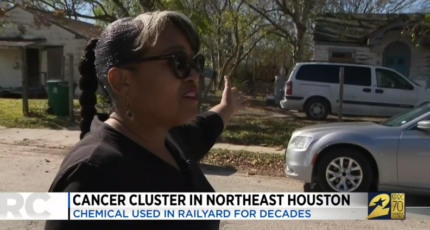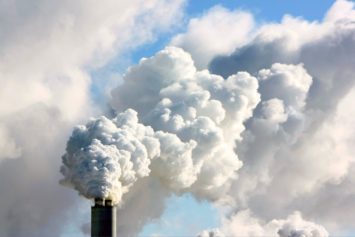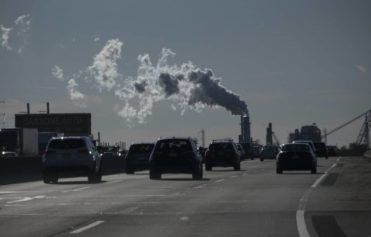
In the historically Black community of Parramore in Orlando, Florida, residents are surrounded by highways. The exhaust produced by the more than 300,000 vehicles that pass through the neighborhood each day has created health problems, including cancer, asthma and other respiratory ailments. (Photo: environmentalstudiesblog)
The struggle for environmental justice in low-income and Black communities continues. This is most certainly the case in Orlando, Florida. In the heart of one of the premier tourist destinations in the United States, the theme park capital of America, the residents of a historically Black community are having trouble breathing due to air pollution — reflecting a nationwide problem.
The community in question is the predominantly Black neighborhood of Parramore in Orlando, Florida, one of the city’s poorest communities, as HuffPost reported. The Griffin Park federal housing project is completely boxed in by highways — Interstate 4 and State Road 408 — and air pollution from over 300,000 cars per day. Trees that would have protected against the noxious fumes of automobiles have been cut down. In Parramore, once a thriving Black middle-class area founded in the 1880s, years of railroad and highway construction, segregation and relocation of residents to Griffin Park have surrounded the community and exacerbated the environmental issues it faces. As the Orlando Sentinel reported, “Griffin Park is a planner’s nightmare — a neighborhood encircled by roads and subjected to noise and pollution 24 hours a day. From a historical standpoint, it’s unsurprising.” The median household income is now $13,613, and childhood poverty is 73 percent, with many children suffering from chronic health problems. Residents suffer from cancer, asthma and other respiratory conditions, and have urged officials to pay attention to their environmental health concerns. City authorities say they will conduct a health assessment of the area in the next five years as part of a beautification plan that is set to include green spaces.
Dee Ann Miller, Deputy Press Secretary of the Florida Department of Environmental Protection (DEP), told Atlanta Black Star that the Orange County Environmental Protection Division and the Department of Health at Orange County have had the most involvement in community-specific air monitoring and assessment in Parramore. “In regard to DEP, we protect Florida’s air quality through ambient air quality monitoring, permitting, and compliance assistance and enforcement for stationary sources of air emissions throughout the state,” she said. “The State of Florida has one of the most robust long-term outdoor air quality monitoring networks in the country, enabling the Department to provide accurate and timely data to the state’s citizens, residents and visitors. DEP has invested nearly $1.5 million during the past three years to modernize Florida’s air monitoring network.”
Miller added that DEP’s monitoring network covers 90 percent of people in Florida, including the Orlando area, and include more than 220 permanent fixed monitoring stations and 101 strategic locations to capture areas of high population density most representative of air quality in the region. “These monitoring stations collect data for ozone, nitrogen dioxide, and particulate matter, among other pollutants. The monitoring site nearest to the location of interest is the Winegard Elementary School monitor, which is located in an area of higher population and traffic density, and which monitors for ozone and particulate matter associated with vehicle emissions,” Miller added. “At present, the ozone level at the Winegard Elementary School monitor is 64 parts per billion (ppb), which is 6 ppb lower than the national ozone standard of 70 ppb.”
Florida scores highly in the nation for clean air, Miller said, pointing to the state’s high rankings in the American Lung Association’s 2017 “State of the Air” report. The report ranked two Florida cities among the cleanest in the country (Cape Coral-Fort Myers-Naples and Palm Bay-Melbourne-Titusville), four cities among the 11 cleanest for year-round and short-term particle pollution (Homosassa Springs, Lakeland-Winter Haven, North Port-Sarasota and Orlando-Deltona-Daytona Beach), and one (Gainesville-Lake City) among the 23 cleanest cities for ozone and short-term particle pollution. The data, which place the state in a favorable light, nevertheless do not reflect the concerns of the Parramore and Griffin Park community, and their concerns over disparate environmental conditions.
Across the country, air pollution has eased since the passage of the Clean Air Act of 1970. Nevertheless, air pollution is responsible for 200,000 premature deaths per year according to an MIT study, with car and truck tailpipe exhaust as the most significant contributor with 53,000 deaths, and electric power generation coming in second at 52,000. The risk of death is highest among Black people, men and the poor. A study released in 2017 by University of Washington researchers found that little progress has been made in bridging the gap between the exposure of people of color versus whites to harmful air pollution from combustible sources. The study, which examined levels of the transportation-related pollutant nitrogen dioxide (NO2) between 2000 and 2010 found that disparities in exposure was greater based on race and ethnicity than by age, education and income. Further, while the overall levels of NO2 declined significantly, the difference in exposure levels between white people and nonwhite people declined only slightly.
According to a report from the NAACP, there are environmental justice challenges facing Florida in the form of air and water pollution, climate change and food shortages for poor people and people of color. The civil rights organization reports that the state ranks third place in levels of CO2 emissions, mostly from electric power generation and transportation. “Cities like Tampa, Miami-Dade, and St. Petersburg have consistently failed to meet EPA air quality standards or have received subpar air quality ratings by the American Lung Association. More often than not, there is a disproportionate number of low-income and people of color living in these cities and municipalities, putting them at a much greater risk for illnesses like emphysema, bronchitis, and lifetime asthma,” the report said. “Non-Latino black adolescents had the highest prevalence of current asthma as well as the highest rates of asthma emergency department visit and hospitalizations.”
The NAACP calls for the involvement of underrepresented impacted communities, along with industry, institutions, and all Floridians to achieve environmental justice and “ensure safe, clean, healthy, and resilient communities in the face of environmental danger and injustice.” In its vision and call to action, the civil rights group says there is a need to rectify the injustice where it has occurred, recognize injustice where it is ongoing, and have accountability so that injustice is unable to thrive.
Increasingly, more people realize the interconnectedness of racial justice and the environment. It is for this reason that the environmental group Greenpeace endorsed the Vision for Black Lives platform, acknowledging the need to confront systems of power that wreck the environment and rob Black people of their humanity. As Greenpeace chief program officer David Barre said, the Black Lives platform connects the dots between racial and environmental justice by calling for a divestment from fossil fuels and investment in community-based solutions, a just, clean energy society in which environmental racism is addressed through more democratic control over natural resources, community involvement in government decisions that impact clean housing, water and food, and a democracy that puts people before corporations by ending Black voter suppression and big money in politics.
The federal government has a role to play in bringing forth environmental justice in Orlando and elsewhere. However, the Trump administration under EPA chief Scott Pruitt has engaged in a rollback of environmental regulations and Obama-era measures to promote clean air and fight global warming. Sen. Cory Booker (D-NJ) wants environmental justice to become the law of the land. He introduced a bill in this session to strengthen environmental protections for low-income people, communities of color and indigenous people. The legislation, the Environmental Justice Act of 2017, also restores a private citizen’s right to sue for environmental justice relief and expands on President Clinton’s 1994 executive order requiring all federal departments and agencies to consider in their decision-making process the potential harmful impact on disadvantaged communities of proposed government projects. Sen. Booker’s bill bears similarities to legislation Rep. John Lewis has introduced.
In Orlando and elsewhere, Black people are disproportionately affected by air pollution and environmental toxins, their health and lives compromised. It will take a collective effort, government, and a movement to turn things around.


